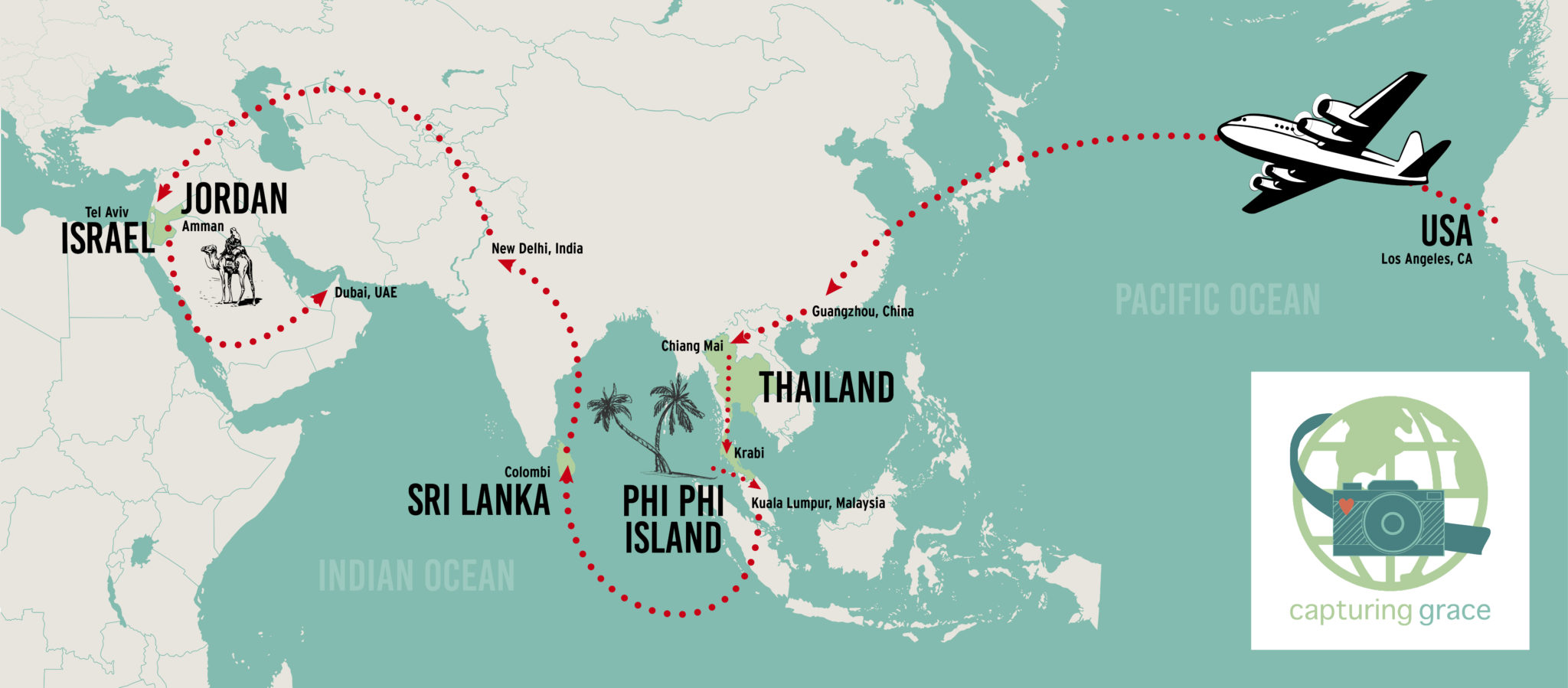
20 Oct Departing for Thailand, Sri Lanka, Israel and Jordan

A big thank you to my friend and amazing graphic artist Michael Livesay-Wright for this really cool travel graphic for my trip
Tomorrow I leave on a five week journey, photographing for ministries in Thailand, Sri Lanka, Israel and Jordan. Consider this post an introduction to ministries and movements that are making a global impact on the 150,000,000 global orphan crisis. Please pray for God to use my photographs and stories to further their cause.

I am so excited for Carol to be with me at the start of my travels as I photograph for the World Without Orphans global Forum in Chiang Mai Thailand.
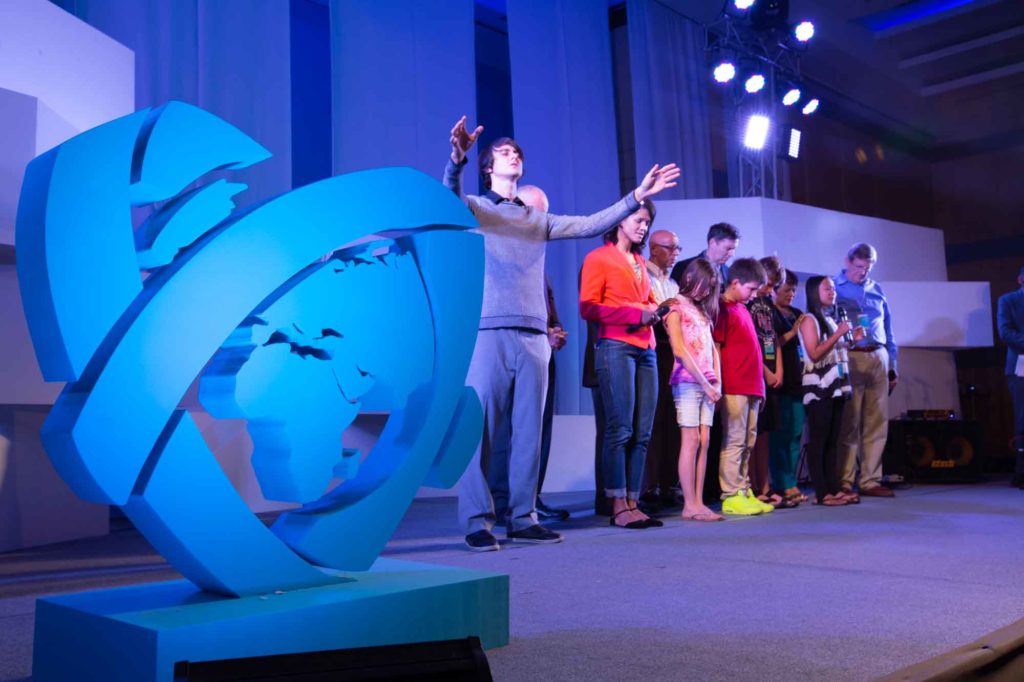
In 2016 I had the privilege of photographing World Without Orphans global Forum in Chiang Mai Thailand and hearing speakers from around the globe who are making a difference in the 150,000,000 global orphan crisis. I have always looked forward to returning.
This will be a strategic gathering for the global Church in advancing efforts to end ‘orphanhood’ and to ensure that all children grow up in safe, stable, and nurturing families.
You can learn more about this event at -https://www.worldwithoutorphans.org/
After my time in Thailand I continue on to Sri Lanka to photograph at City of Hope for SOW (Serving Orphans Worldwide).
This video tells the story of where I will be. I am so excited to provide portraits of these beautiful children for their sponsors.
ORPHAN CRISIS IN SOUTH ASIA
This part of South Asia only recently emerged from a 26 year civil war, during which time they also experienced the tragedy of a major tsunami in 2004. Ever since emerging from the war, the country’s government has tried to work towards economic recovery. As of 2014, nearly 90,000 people were still internally displaced as a result of the conflict, creating widespread poverty and homelessness. As a result, many children are left abandoned. These vulnerable children face extreme difficulties, including forced child labor, HIV/ AIDS, and substance abuse. This part of South Asia is also currently dealing with the issue of trafficking, as it is a major source country for human trafficking of men, women, and children. The unstable society makes it even more difficult for children, who are often exploited and abused.
CITY OF HOPE CHILDREN’S HOME
Beginning in 2005, plans were made to build an orphanage in this particular region in South Asia. For years, they prayerfully gathered resources and asked that God would complete the work He had begun. Finally, an organization came alongside and helped fund the completion of the home. By 2009, City of Hope had altogether more than 10,000 square feet of facilities to care for orphaned children. Today, City of Hope is home to more than 40 boys and girls. The home has become a place known to protect and provide for the hurt and wounded children of their society. City of Hope was originally called Kalamusu Kadella, translated “the nest of many colors.” It is a fitting title. This home is much like a nest, where children from wildly varying circumstances can come. In this nest, they are well cared for. They are nurtured back to health. And, most importantly, they are loved.
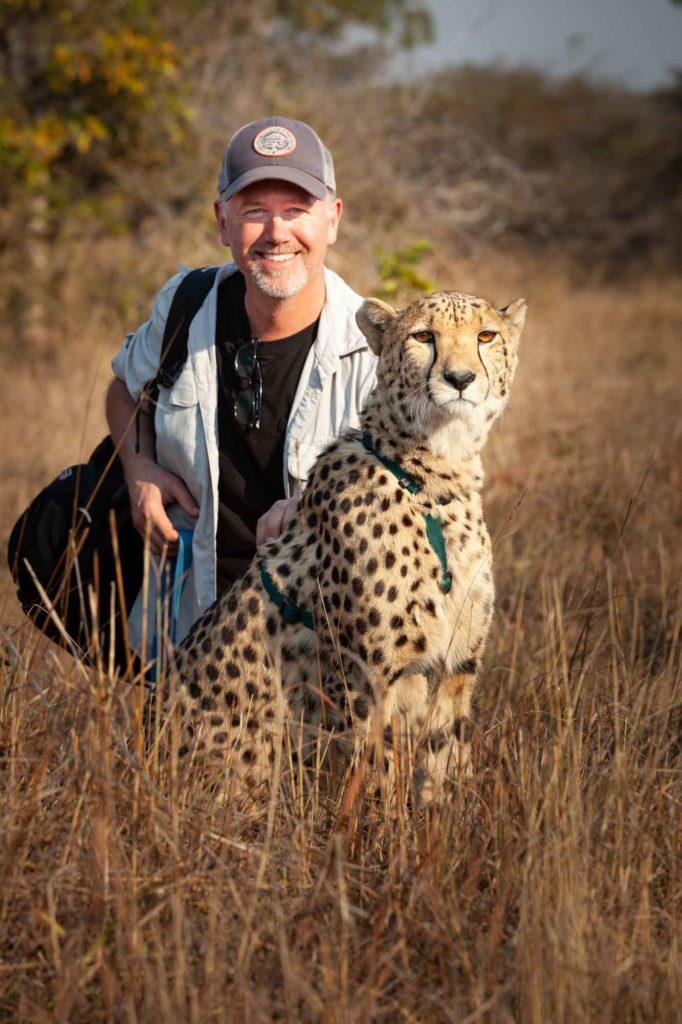
In 2015 I had the privilege to photograph for Every Orphans Hope in Zambia, becoming good friends with its founder and CEO, Gary Schneider. Since then, God has allowed Gary and I to serve together in various capacities around the world.
Meeting Gary in Israel and photographing Orphan Sunday events in Jerusalem (Orphan Shabbat) and Jordan during November will be a dream come true.
For churches in over ninety countries around the world to set aside the second Sunday of November is a miracle, a dream that God placed in Gary Schneider’s heart 18 years ago as he stood in a tiny village church in Zambia.
On that day, Gary witnessed a local Zambian pastor plead with his congregation to give from their hearts to the orphans of their village. As widows and others with very little came forward and gave what they had (their own shoes, a head of cabbage), Gary’s heart stirred for what could happen if churches around the world would call their people to do the same.
Now this yearly event is changing the lives of orphans in ninety countries around the globe. I am so excited to be a part of these two services and witness what God is doing in this part of the world through those whose hearts beat for the least of these.
During my time in Israel I will photograph for an orphanage that dates back to the holocaust. In Jordan I will be photographing for a ministry that shelters refugee children from Iraq who have escaped ISIS, as well as providing photographs for the first Orphan Sunday website in the Arabic language.
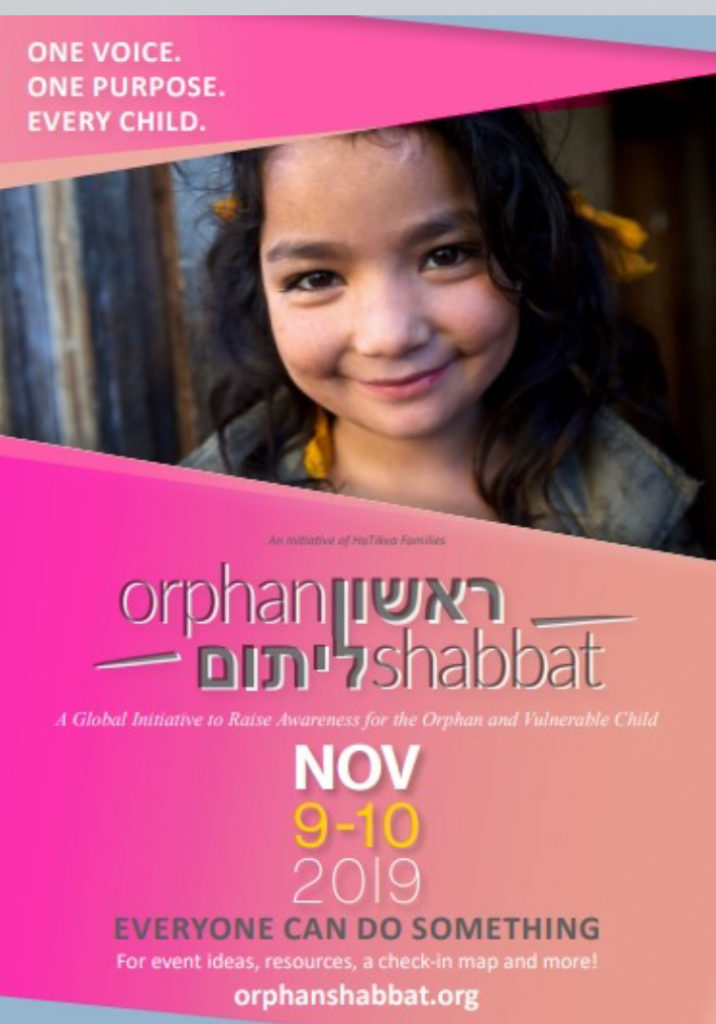
Photographing Orphan Shabbat in Isreal on November the 9th. Excited to meet and work with Rebecca Rikhi and HaTikva Families. You can read more about this beautiful ministry at hatikvaproject.org
I love that the “face of Orphan Shabbat” came from my trip high in the mountains of the Himalayas in 2016’. Her face captured my heart on that trip and now it will capture the hearts of people in Israel.
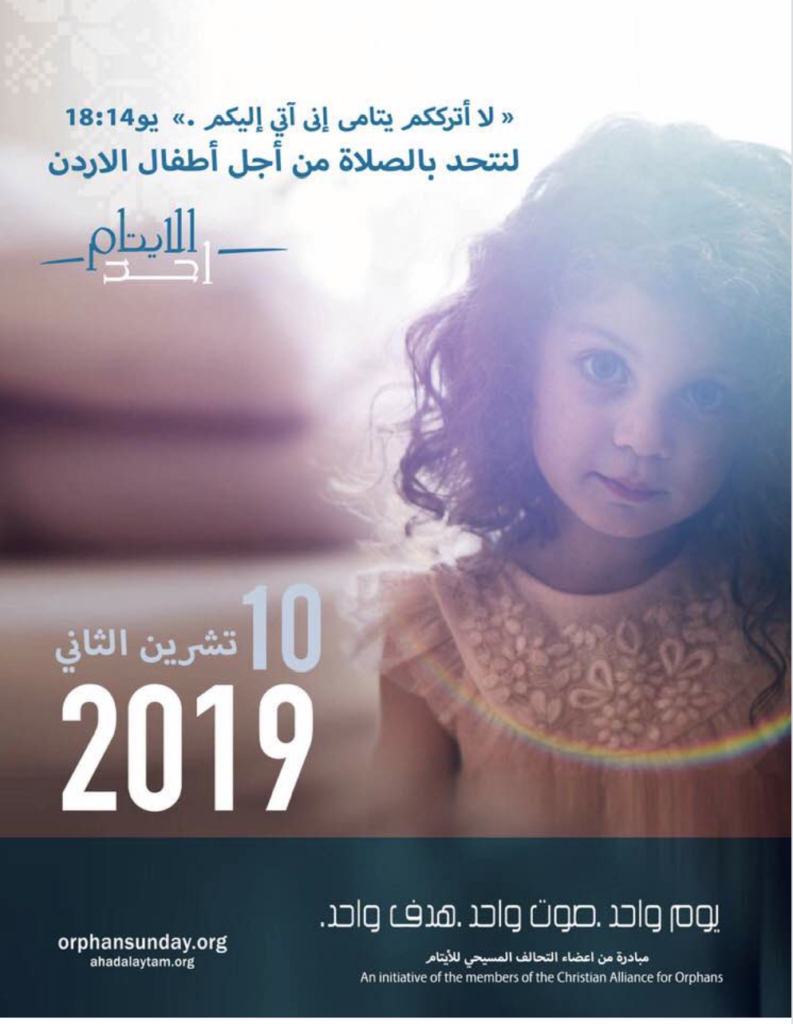
Photographing this years Orphan Sunday event in Amman Jordan, looking forward to meeting Nisreen Hawatmeh, the Orphan Sunday Coordinator for Jordan and photographing for the first Orphan Sunday website in Arabic. http://orphansundayjo.org/ar/node/13
At the end of this five week journey my daughter Carissa will join me in Amman Jordan for an adventure on the 400 mile Jordan Trail.
Together with our bedouin guide Ghassab, we will hike a forty mile segment (from Dana to Petra) over six days, sleeping under the stars in Bedouin tents and caves.
The story of this trailFrom Condé Nast -“Until I walked across Jordan, I had never fully grasped the diversity of its landscape. We leave Dana and descend 4,000 feet into the Dana Biosphere Reserve’s central valley, taking in four unique ecosystems. Lonely cypress trees give way to Martian-like rock formations. Then the landscape changes to bone-dry river beds lined with palms and oleander, before, finally, becoming rust-hued desert. Our hiking boots stomp over fossilized urchins that once lived in the Tethys Seas, sending electric blue lizards running for cover.The accommodations along the trail range from an off-the-grid eco-lodge to camping tents and beit al-sha’ar, Bedouin-style tents stitched from black goat hair and outfitted with beds. Part of the goal of the Jordan Trail is to support local Bedouin communities along the route and help preserve the culture of these nomadic desert dwellers. Every stay provided an intimate glimpse into traditional Bedouin life and thoroughly convinced me that Bedouins must have hospitality embedded in their DNA.When we reach Petra on the fourth day I expect my reverie of solitude to be broken. We arrive through the rarely used “back door.” Unlike the tourist-congested main entrance known as the Siq, the back is completely empty. There are no gates or signs, and only a small ticket office. After walking through wilderness and empty desert landscape, I approach our transition to rose-hued World Heritage territory with nervous anticipation. There’s always the fear that that such a monumental site won’t live up to its hype.Vibrant red, white, and pink-colored cliffs tower above us like a melting sunset as we follow the trail for 15 more minutes. Then suddenly, we round a sharp bend and Ad Deir, or the Monastery, Petra’s largest monument, appears in front of us like a mirage. This unfathomable 147-foot-tall façade chiseled into the mountainside is all the more remarkable when you learn that it dates back to the first century BC. Typically, the Monastery is the last stop for visitors and requires climbing 850 stone stairs from Petra’s main entrance. The path less followed rewards us with a tour bus-free first impression and an easy, downhill route past canyons and sun-baked plains.
Most visitors spend three hours in Petra. We allow ourselves nearly a full day to explore the Nabataean tombs, amphitheaters, and aqueducts. The next day we enter, as most tourists do, through the Siq, a narrow gorge that’s just ten feet wide in some places. The Treasury’s two-story façade with its intricate Greek-inspired columns would still be awe-inspiring amidst selfie-sticks and bus tours, but we find ourselves eerily alone, sharing the moment with a few camels and a single tour group.
Petra is a marvel and the views and scenery you take in when getting here on foot are worth the blisters and sunburn. But it’s the people you meet along the way that make the experience so special. When I say goodbye to Petra, I pass a Bedouin woman in her souvenir stall. I decline her fossilized stones, but as I walk away she offers me tea for my onward journey.”



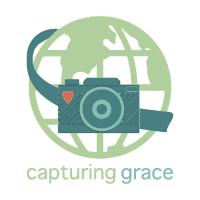
No Comments